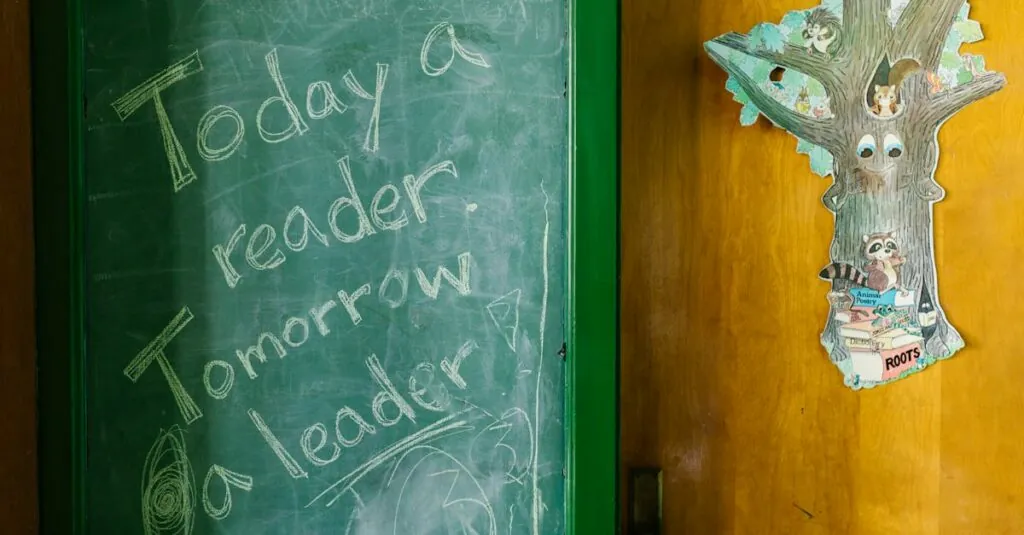Table of Contents
ToggleEducation is meant to be the great equalizer, but lately, it feels more like a game of dodgeball where everyone’s dodging the real issues. From outdated curricula to the digital divide, schools are grappling with challenges that can make even the most seasoned educators want to pull their hair out. And let’s face it, who doesn’t enjoy a little educational chaos now and then?
As classrooms evolve, so do the hurdles. Teachers are juggling everything from mental health crises to budget cuts, all while trying to keep their students engaged. With so much at stake, it’s crucial to dive into the major issues in education today. After all, if we don’t address these problems, the future generation might just end up Googling “how to adult” instead of learning the skills they really need.
Overview of Major Issues in Education Today
Outdated curricula hinder students from acquiring relevant skills, leaving many ill-prepared for modern challenges. Additionally, the digital divide prevents equal access to online resources, creating disparities among student populations. Teachers face mental health crises that impact their ability to deliver quality education effectively. Budget cuts exacerbate these problems, leading to larger class sizes and fewer resources.
Engagement remains a critical issue, as keeping students interested in learning proves increasingly difficult. The pressure to improve standardized test scores often limits creative teaching opportunities. Schools struggle with inadequate mental health support for students, contributing to rising anxiety and stress levels among youth.
Furthermore, equitable funding for public schools varies significantly across districts. High-poverty areas typically experience greater challenges, impacting educational outcomes. Teacher retention suffers due to insufficient support and increasing workloads, leading to a shortage of qualified educators.
Families often deal with the consequences of these educational issues, with increased frustration when seeking adequate support. Students benefit from hands-on learning experiences, yet practical application often takes a backseat to traditional classroom methods. Addressing these major issues in education today will ensure a better foundation for future generations equipped with essential life skills.
Inequality in Education
Inequality in education manifests significantly through various dimensions, particularly socioeconomic and resource access. Addressing these disparities remains crucial.
Socioeconomic Disparities
Socioeconomic status directly impacts student performance and access to quality education. Families with lower incomes often struggle to provide necessary academic support. Schools in affluent areas typically receive more funding, enabling better facilities and resources. Students from disadvantaged backgrounds face barriers that hinder their academic success. District funding disparities exacerbate this issue, leading to unequal opportunities across regions. Education systems that focus on equitable funding can help bridge this gap.
Access to Resources
Access to educational resources varies widely between districts. Schools in lower-income areas frequently lack essential materials, technology, and extracurricular programs. Students without access to technology face challenges, especially in increasingly digital learning environments. High-quality teachers often gravitate toward well-funded institutions, leaving underprivileged schools with less experienced staff. Communities investing in educational resources create better chances for all students. Equal distribution of learning materials and technology reduces gaps and improves overall performance.
Standardized Testing
Standardized testing remains a significant issue in education today. This method of assessment, while intended to evaluate student learning across various demographics, often constrains educators and students alike.
Impacts on Teaching
Teaching strategies frequently suffer due to the emphasis on standardized testing. Teachers feel pressure to align their curricula strictly with test content. Creativity in lesson planning diminishes when the priority shifts toward preparing students for specific tests. While standardized tests aim to provide a level playing field, they can lead to a narrow focus on memorization rather than critical thinking. Additionally, professional development opportunities for teachers can become limited as institution budgets allocate more resources to test preparation.
Effects on Students
Students experience considerable stress related to standardized testing. Anxiety levels often rise as they prepare for these assessments, which can negatively impact their performance. Engagement in learning may decline when students perceive their education as merely a means to ace a test. The emphasis on test scores sometimes leads to a lack of emphasis on essential skills, such as problem-solving and collaboration. Disparities in testing outcomes reflect broader societal inequities, making it vital to reassess the role of standardized tests in determining student success.
Teacher Shortages
Teacher shortages pose a significant challenge to the education system, impacting student learning and classroom environments nationwide.
Causes of the Shortage
Increased teacher demand outpaces supply, leading to staffing challenges across many districts. Low salaries discourage potential educators from entering the profession. High levels of stress and burnout contribute to lateral exits, with teachers leaving for less demanding jobs. Unmanageable workloads further compound this issue, making retention difficult. Additionally, college graduation rates in education fields have seen declines, resulting in fewer qualified candidates available to mentor students. Inequitable working conditions also exist, as underfunded schools struggle to compete for qualified instructors.
Consequences for Students
Students experience negative effects due to the teacher shortages, impacting their educational experiences. Increased class sizes lead to less individual attention, hampering the learning process. Inexperienced teachers may fill gaps, often lacking the skills needed for effective teaching. Learning outcomes suffer, particularly in underserved communities, where staffing ratios are the highest. Increased turnover disrupts curricular continuity, contributing to student disengagement. The lack of sufficient mentors limits students’ access to personalized guidance essential for academic success.
Mental Health and Well-Being
Mental health and well-being in education remains a crucial concern. Support systems play a significant role in fostering a healthy environment for both students and educators.
Importance of Support Systems
Support systems help address mental health challenges. Schools need to implement counseling services that cater to students’ emotional needs. Creating an environment that encourages open conversations about mental health fosters trust and vulnerability. Teachers also benefit from professional development programs focused on coping strategies, reducing burnout. Training staff to recognize early signs of mental health issues enhances overall support. Establishing clear communication channels between students, teachers, and counselors strengthens these systems. When schools prioritize mental health resources, engagement and academic performance improve. A supportive network leads to healthier learning environments, which ultimately benefits student achievement.
Addressing Stigma
Addressing stigma is vital for improving mental health awareness. Schools must promote the idea that seeking help is a strength, not a weakness. Campaigns highlighting mental health topics can normalize conversations and reduce fear surrounding these discussions. Mandatory training for teachers equips them to address these issues effectively within classrooms. Open dialogues encourage students to share their experiences without fear of judgment. By integrating mental health education into curricula, schools create informed communities. Fostering an atmosphere of understanding helps break down barriers, making it easier for students to seek assistance. Overcoming stigma around mental health leads to healthier, more resilient students, ultimately enhancing their overall educational experience.
Technology in Education
Technology plays a pivotal role in shaping modern education. It creates opportunities for innovative teaching methods while also presenting distinct challenges.
Benefits and Challenges
Incorporating technology in education brings various benefits. Interactive learning tools engage students more effectively compared to traditional methods. Access to online resources enhances self-directed learning, allowing students to explore topics in depth. However, challenges arise as well. Teachers often face difficulties integrating technology into their curricula due to inadequate training. The reliance on technology can distract students, diluting their focus on fundamental skills. Additionally, not all students possess equal access to devices or reliable internet, which creates disparities in learning experiences.
Equity in Access
Equitable access to technology remains a pressing issue in education. Schools in affluent areas frequently benefit from advanced technological resources, while underfunded institutions struggle to provide basic devices. Disparities in investment perpetuate inequality, impacting students’ ability to succeed. Access to technology directly correlates with student achievement; those without proper resources face significant challenges. Ensuring all students benefit from technological advancements requires targeted funding and policies aimed at closing the digital divide. Bridging this gap enhances opportunities for all learners, fostering an inclusive educational landscape.
The challenges in today’s education system require urgent attention and action. Addressing the disparities in funding and resources is crucial for leveling the playing field for all students. The focus on standardized testing must shift to foster creativity and critical thinking in classrooms.
Moreover, tackling teacher shortages and providing adequate mental health support can significantly improve the learning environment. Schools need to embrace technology while ensuring equitable access for every student.
By prioritizing these issues, the education system can evolve into a more effective and inclusive space that prepares future generations for success.




